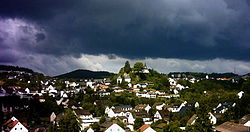Daun (Germany)
| Daun | ||
|---|---|---|
 |
||
|
||
| Coordinates: 50°11′55″N 6°49′55″E / 50.19861°N 6.83194°ECoordinates: 50°11′55″N 6°49′55″E / 50.19861°N 6.83194°E | ||
| Country | Germany | |
| State | Rhineland-Palatinate | |
| District | Vulkaneifel | |
| Municipal assoc. | Daun | |
| Government | ||
| • Mayor | Wolfgang Jenssen (SPD) | |
| Area | ||
| • Total | 48.97 km2 (18.91 sq mi) | |
| Elevation | 410 m (1,350 ft) | |
| Population (2015-12-31) | ||
| • Total | 7,994 | |
| • Density | 160/km2 (420/sq mi) | |
| Time zone | CET/CEST (UTC+1/+2) | |
| Postal codes | 54550 | |
| Dialling codes | 06592 | |
| Vehicle registration | DAU | |
| Website | www |
|
Daun is a town in the Vulkaneifel district in Rhineland-Palatinate, Germany. It is the district seat and also the seat of the Verbandsgemeinde of Daun.
The town lies in the Vulkaneifel, a part of the Eifel known for its volcanic history, geographical and geological features, and even ongoing activity today, including gases that sometimes well up from the earth. Daun lies south of the High Eifel on the river Lieser. Found from 2.5 to 3.5 km southeast of Daun’s town centre are the Dauner Maare, a group of three volcanic lakes separated almost wholly by only the walls of tuff between them. The town is home to the Eifel-Vulkanmuseum. Daun is furthermore a spa town and has mineral water springs.
The district seat of Daun has 8,514 inhabitants (as of 31 December 2005, counting only those with their main residence in the town). Besides the main town, also called Daun (4,264 inhabitants), the municipal area also includes these outlying centres (Stadtteile) that were formerly self-administering municipalities:
The first settlement in the area came as early as the 7th century BC by which time the Celts had settled the fortified basalt mountain in Daun. The Romans, too, used this prominent hill in the Lieser valley as a watch post, as witnessed by Roman finds. The placename may have come from the Celtic-Roman word Dunum, meaning either “fence” or “fortified heights”, that is to say, a fort.
In the late 10th century, a castle complex belonging to the free Lords of Daun arose here. In 1075, Daun had its first documentary mention in a townsman named Adalbero de Duna.
In 1163, the free lords’ family died out. One of the family’s ministeriales, Richardus de Duna, took over his former Lord’s name and even the coat of arms with the Daun fretting. In 1337, Daun is mentioned for the first time as being a town. In 1346 came a grant of town rights along with market rights, and Daun became at the same time the location of a high court.
...
Wikipedia



